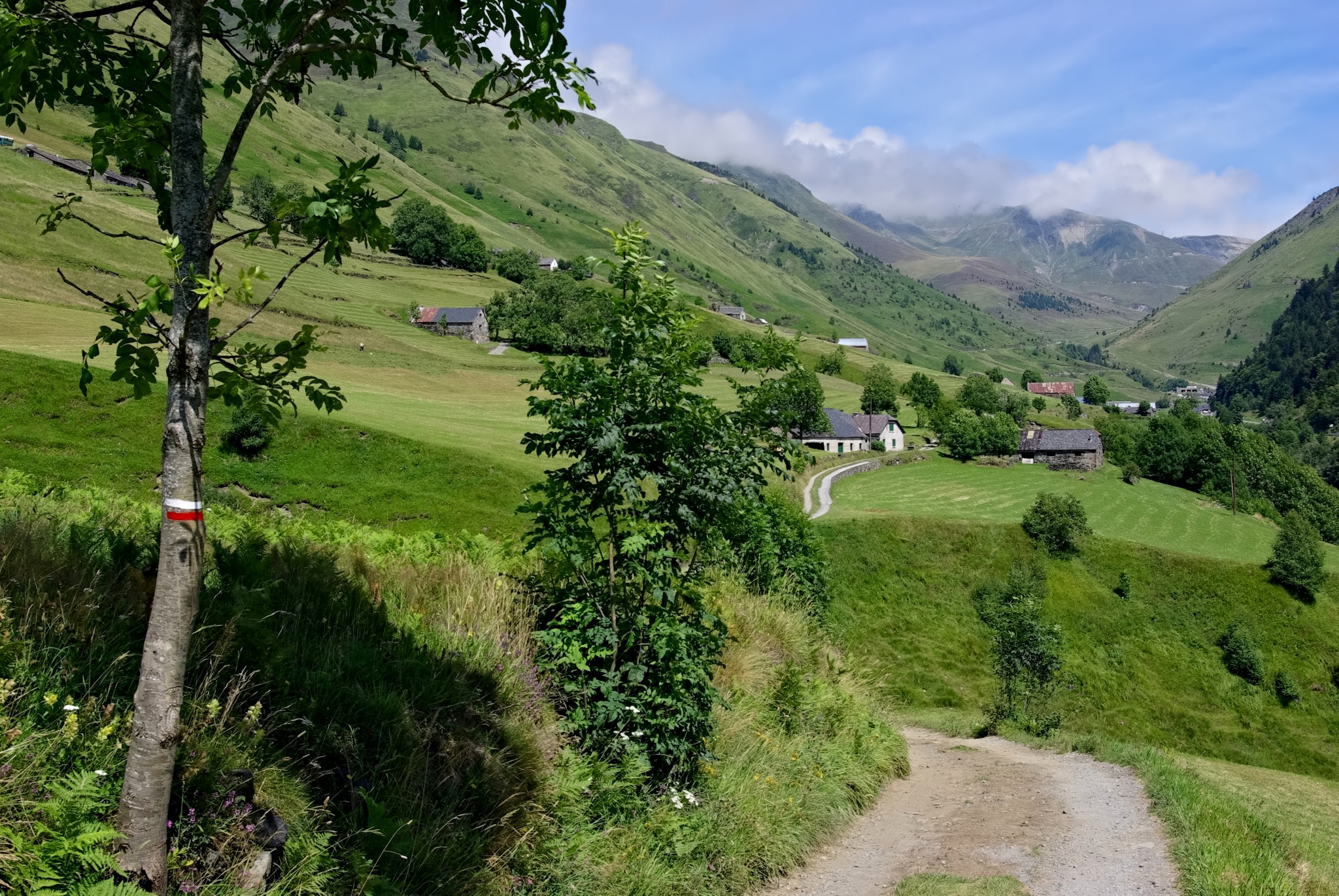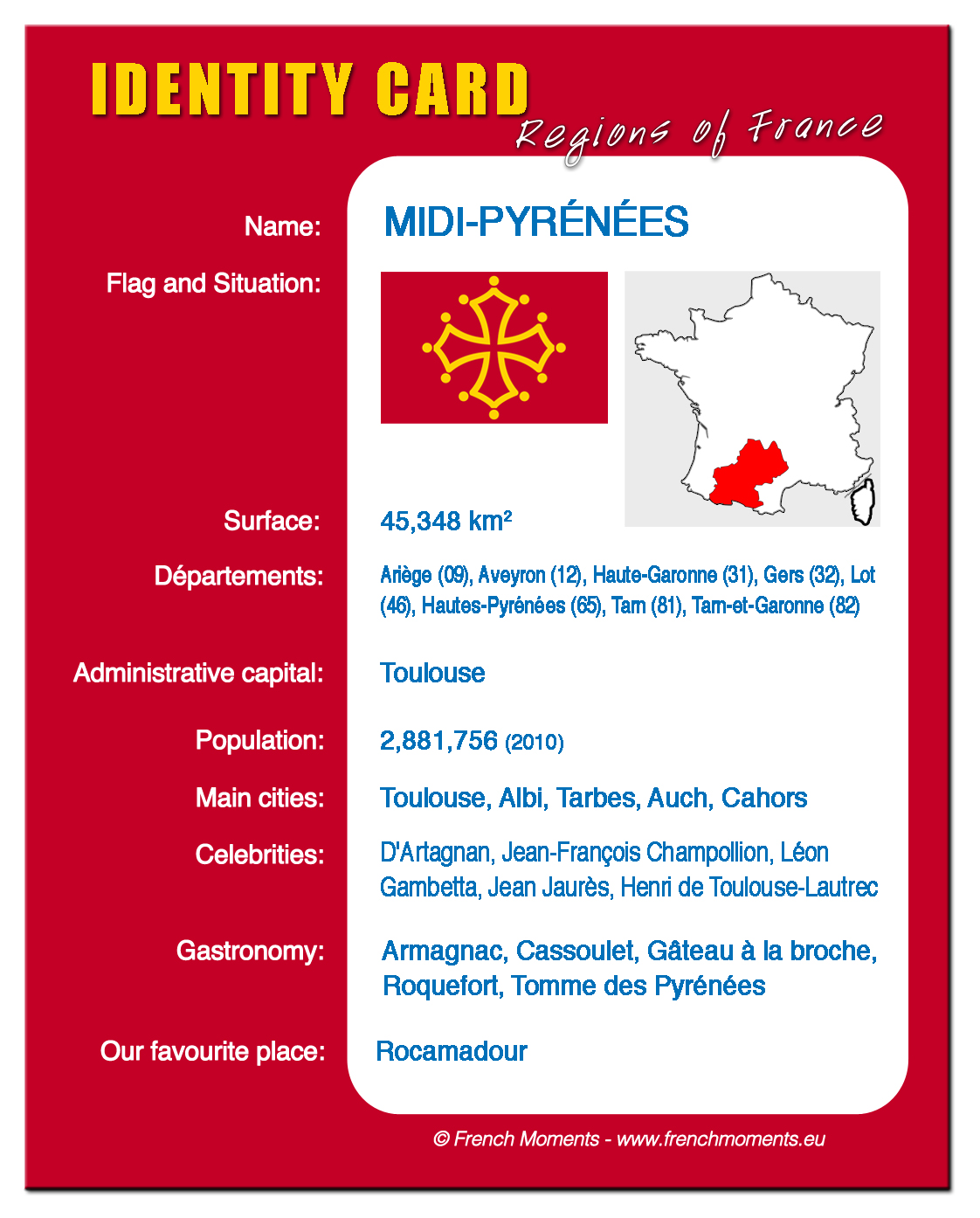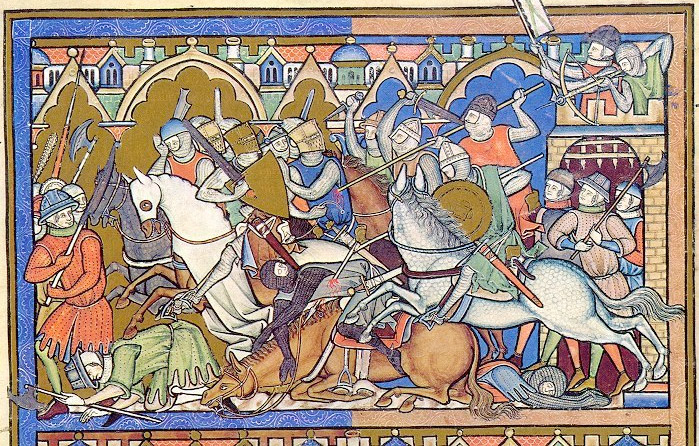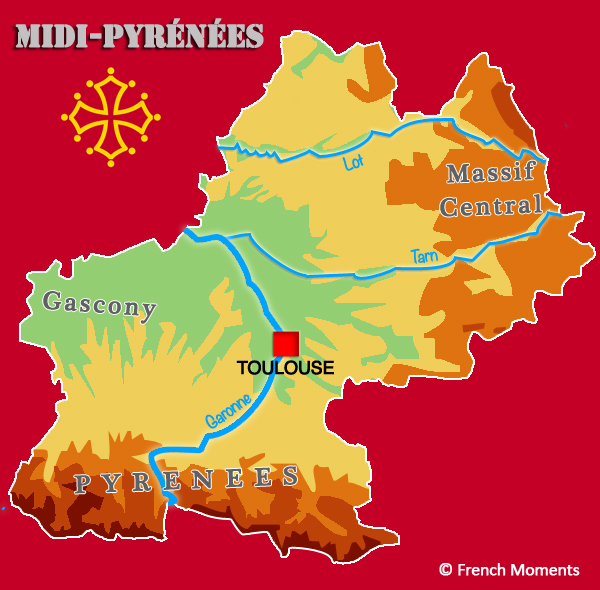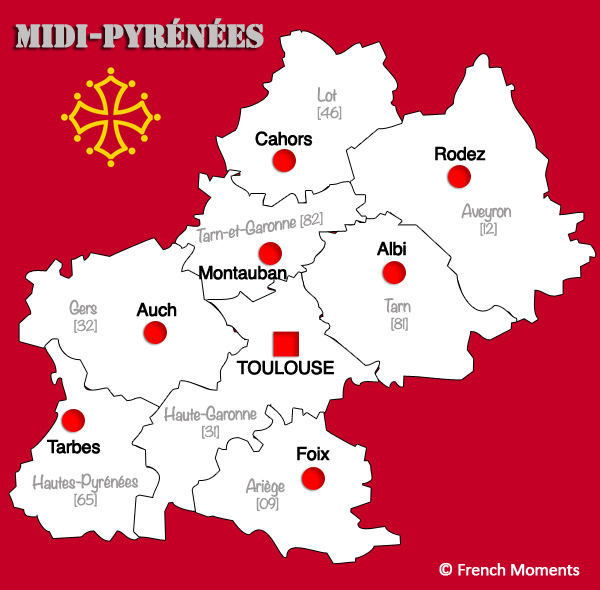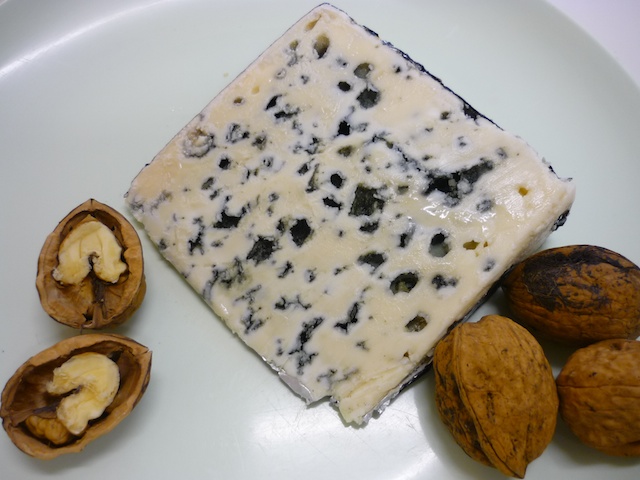Midi-Pyrénées: “The region where the living is good”.
- Name: Midi-Pyrénées
- Area: 45,348 km2
- Départements: Ariège (09), Aveyron (12), Haute-Garonne (31), Gers (32), Lot (46), Hautes-Pyrénées (65), Tarn (81), Tarn-et-Garonne (82)
- Administrative capital: Toulouse
- Population: 2,881,756 inhabitants (2010)
- Main cities: Toulouse, Albi, Tarbes, Auch, Cahors
- Celebrities: D’Artagnan, the egyptologist Jean-François Champollion, Léon Gambetta, Jean Jaurès, Jean-Auguste-Dominique Ingres, Henri de Toulouse-Lautrec…
- Cheese: Roquefort, Bleu de Causses, Rocamadour, Tomme des Pyrénées
- Traditional dishes: Cassoulet, Foie gras, Magret, Confit de canard, Gâteau à la broche, Garbure, Aligot, Pastis
- Our favourite places: Gavarnie, St Cirq-Lapopie, Cordes-sur-Ciel, Rocamadour, Pic du Midi…
History of Midi-Pyrénées
The Midi-Pyrénées Region has a long history. It was the Roman conquest in 200 BC which was decisive, initiating a long period of prosperity.
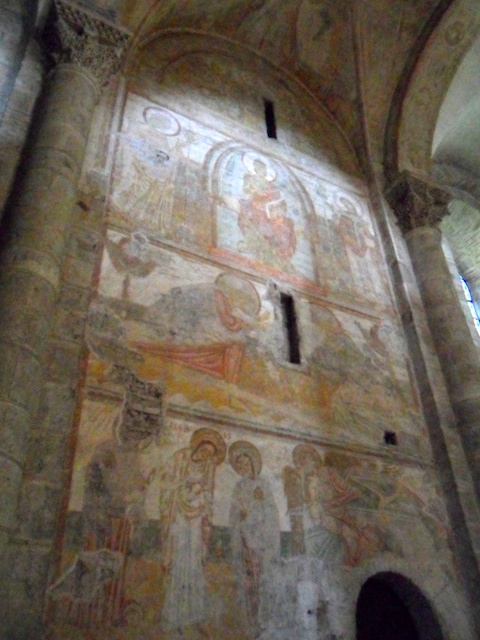
The Midi-Pyrénées Region was part of the Roman Empire before being invaded by the Visigoths during the fifth century. Between the 3rd and the 5th centuries, successive invasions by the Alemanni, the Vandals and the Visigoths swept the region and Toulouse became capital of the Visigoth Kingdom. Contrary to what one may think, the Visigoths were not the Barbarians they are often described as having been. In fact they developed early forms of agriculture and didn’t end Roman law and so the region kept a high degree of civilisation. They even respected Christians, who were allowed to worship in the region. In 801, Charlemagne marched into Spain and absorbed Catalonia into his Empire, although he allowed it a degree of autonomy. After his death, the Counts of Toulouse took control of seven cities and of the Rouergue province, asserting their power by launching great construction programs.
In the 1200s, Catholics were not that tolerant when the Cathars started following their own beliefs. The Cathars were declared heretics and the Albigensian crusade was lead to end their cult in the region. By the end of the crusade the Catholic Church began the construction of the massive Sainte-Cécile cathedral in Albi to show their domination over this land. A century later, the Quercy and Rouergue provinces were ceded to the King of England (although many years later the 1659 Treaty of Pyrenees restored them to the French crown). In 1271 Toulouse came under French rule.
In 1484, the Kings of Navarre gained control of the Pays de Foix and Bigorre territories and held them until 1512, when King Ferdinand of Spain reclaimed them. Both territories were returned to France in the 17th century.
During the sixteenth century, the region underwent important economic expansion due to the culture of Pastel. The Pastel is a plant with green leaves and yellow flowers that is used to create a blue colour used by dyers and artists. Midi-Pyrénées was the most important exporter of the Old Continent with more than 40,000 tons per year sent to London, Hamburg and to the Orient. Such trade resulted in the massive enrichment of the region and the appearance of the expression “Pays de Cocagne” (land of plenty) from the word used to describe the bricks of Pastel. The Napoleonic era witnessed the discovery of the Pyrenees’ first thermal springs, which were transformed into fully-fledged spa resorts under the Second Empire and the Third Republic. During World War II, the Pyrenees proved to be of vital importance to the French Resistance movement.
The Midi-Pyrénées region was created in 1956. Midi-Pyrénées is the largest region of metropolitan France (French Guyana being the largest overseas) with more than 45,000 square metres. Even larger than eight of the European Union states (Denmark, Switzerland, Netherlands…). But it is also one of the most sparsely populated areas in France, with approximately 2.9 million inhabitants. The region is made up of 8 départements: Aveyron, Ariège, Lot, Gers, Haute-Garonne, Hautes-Pyrénées, Tarn and Tarn-et-Garonne. Many rivers cross the region including the Garonne, the Tarn, the Aveyron or the Gers which give their names to departments. As a matter of fact, the historical flag of Languedoc, the Occitan cross, was adopted as the official flag of the Midi-Pyrénées region by the regional council. This historic flag design is itself derived from the coats of arms of the old county of Toulouse.

The region’s activity is mainly focused on Toulouse, the fourth biggest French city (449,328 in 2012), and the sixth largest French conurbation (651,584 in 2006). Agriculture remains the most important activity in the region. Midi-Pyrénées is indeed the second biggest agricultural region in France. It includes the fat poultry from Gers, the dairy sheep from Aveyron and large cereal cultures alongside Gaillac or Cahors vineyard. A great variety of sites encourage tourism in Midi-Pyrénées, with historical and culinary cultural heritage. Indeed, tourism is an important part of the region’s activity, thanks to various historical sites, nature-friendly hiking trails and winter sports stations in the Pyrenees. Every year, 15 million tourists visit the region.

Several historically important people were born in Midi-Pyrénées including D’Artagnan, the Egyptologist Jean-François Champollion, Léon Gambetta, Jean Jaurès the father of our current education system, Jean-Auguste-Dominique Ingres and Henri de Toulouse-Lautrec…
Geography of Midi-Pyrénées

Landscapes of Midi-Pyrénées
Midi-Pyrénées is one of the larger regions in France, but comprises less than 5% of the total population. It brings together old historic provinces or a part of them: Comminges, Couserans and Foix county in the Pyrenees (16.6% of Midi-Pyrénées); most of the Gascony on the West side (24.2%); the north side of the Languedoc around Toulouse and Albi (23.4%); Quercy (15.4%), Rouergue (19.9%) and a little part of Guyenne in the north (0.5%).
This region boasts many mountains, valleys and lakes. The Midi-Pyrénées climate is generally made up of cold Winters and warm Summers. There are lots of regional variations, depending on local conditions and terrains.
Topography of Midi-Pyrénées
The foothills of the Massif Central are made up of plateaus, deep carved valleys and many gorges (Lot, Aveyron…) with cold temperatures in Winter because of the higher altitude, which is why this part of the region is dedicated to breeding farms.
Gascony, north of the Pyrenees and in the middle of the region, is composed of hills, green valleys and plains. An oceanic climate presides over the hilly terrain and agriculture is developed and diversified thanks to the low altitude (200 to 400m) and many rivers flowing through the landscape. It is a landscape of varying hues of green and yellow – from the golden cornfields and expanses of sunflowers whose heads bob gently in the warm breeze, to rolling pastureland punctuated with small copses. This is why many tourists call this area the French Tuscany.

The Pyrenees are a mountain range in the southwest of Europe which divide France and Spain as a natural border. The steepest slope of the Pyrenees is found on the French side, where the runoffs are torrential and become a real wall in places (Roncevaux Pass). The Pyrenees rise above the plains in the south of the region with many peaks such as Aneto Peak, Mont Perdu above 3000m marking the border with Spain. The mountains extend for about 430km from the Bay of Biscay to the Mediterranean Sea. Low passes are lacking and the main roads and railroads between France and Spain run only in the lowlands at the western and eastern ends of the Pyrenees, near sea level.

The climate of Midi-Pyrénées
Midi-Pyrénées has two distinct climatic regions: mountainous in the Pyrenees and continental or oceanic on the plains.
Temperatures can range between extremes of 44°C and -21°C but annual extremes of 26/28°C and -0°/-5°C are much more frequent.
- Record high temperature: 44°C in Toulouse on 8 August 1923.
- Record low temperature: -21°C in Auch on 16 January 1985.
The Midi-Pyrénées region is located in the south of France and is renowned for its warm and pleasant climate throughout the year, especially during the summer months when peak temperatures are experienced. With an average of 2,000 hours of sunshine a year, Midi-Pyrénées is one of the sunniest regions in France. Temperatures above 25°C are recorded on 60 to 80 days of the year over most of the region.

Midi-Pyrénées is situated between the Aquitaine and Languedoc-Roussillon regions. As a result, Midi-Pyrénées boasts oceanic, mediterranean and continental weather influences. That means that there is significant variation in the climate over this French region.

These differences in the climate also occur because of the diversity of topography within this region of France. With the Pyrenees to its south and the Massif Central mountains to the north, the Midi-Pyrénées climate and weather are influenced from both sides. Thus temperatures can be really high during summer and really low during winter, with massive snowfalls on the mountains. In the hinterland, though, the weather is a little milder. In summer the temperatures are pleasantly warm. The mountains always have a cooling breeze and there are rushing streams and tranquil mountain lakes for a refreshing dip after a hard climb. Summer is a good time for mountain sports such as paragliding, white water rafting, caving, walking and mountain biking.

In Autumn (mid September-October) the valleys are bright with colour as the leaves turn every shade of orange, red and yellow. The trails are quiet again and the late-flowering plants are crowded with butterflies. The weather will be cooler, ideal for walking and cycling.
Winter is wonderful in the Pyrenees. The ski season at the largest resort of the French Pyrenees begins on the last weekend of November and runs through to mid-April. The Pyrenees receive more snow than the Alps, but have a pleasantly mild climate without the bitter January temperatures.
The administration of Midi-Pyrénées
Midi-Pyrénées is the largest region of metropolitan France. It is divided into eight départements:
Ariège

- Département code: 09
- Préfecture: Foix
- Sous-préfectures: Pamiers, Saint-Girons
- Number of communes: 332
- Surface: 4,890 km2
- Population: 152,038 (2010)
Aveyron

- Département code: 12
- Préfecture: Rodez
- Sous-préfectures: Millau, Villefranche-de-Rouergue
- Number of communes: 304
- Surface: 8,735 km2
- Population: 276,805 (2010)
Haute-Garonne

- Département code: 31
- Préfecture: Toulouse
- Sous-préfectures: Saint-Gaudens, Muret
- Number of communes: 589
- Surface: 6,309 km2
- Population: 1,243,641 (2010)
Gers

- Département code: 32
- Préfecture: Auch
- Sous-préfectures: Condom, Mirande
- Number of communes: 463
- Surface: 6,257 km2
- Population: 188,159 (2010)
Lot

- Département code: 46
- Préfecture: Cahors
- Sous-préfectures: Figeac, Gourdon
- Number of communes: 340
- Surface: 5,217 km2
- Population: 174,578 (2010)
Hautes-Pyrénées

- Département code: 65
- Préfecture: Tarbes
- Sous-préfectures: Argelès-Gazost, Bagnères-de-Bigorre
- Number of communes: 474
- Surface: 4,464 km2
- Population: 229,458 (2010)
Tarn

- Département code: 81
- Préfecture: Albi
- Sous-préfectures: Castres
- Number of communes: 323
- Surface: 5,758 km2
- Population: 375,379 (2010)
Tarn-et-Garonne

- Département code: 82
- Préfecture: Montauban
- Sous-préfectures: Castelsarrasin
- Number of communes: 195
- Surface: 3,717 km2
- Population: 241,698 (2010)
Midi-Pyrénées’ main cities

The population of Midi-Pyrénées main agglomérations*:
- Toulouse: 858,300
- Tarbes: 77,600
- Albi: 70,900
- Montauban: 62,200
- Castres: 53,300
- Rodez: 40,000
- Auch: 25,000
- Millau: 23,600
- Cahors: 23,400
“Agglomérations” in France are contiguously built-up areas in France, also called “unité urbaines”.
Economy of Midi-Pyrénées
Employment in the Midi-Pyrénées is divided between 76 % in the service sector, 13 % in the manufacturing sector, 7 % in construction et 4 % in agriculture. Midi-Pyrénées also boasts the first trade surplus in all French regions. The principal commercial partners of Midi-Pyrénées are Germany, China, Singapore, USA and the UK.
Midi-Pyrénées realises 4% of the French GDP and in 2012 the unemployment rate was at 10%. The region is the first national centre for microbiology research, spatial research and aeronautics and the second for biotechnology. Midi-Pyrénées occupies 8.3% of France’s area with just 4.5% of total population.
The Primary sector
Agriculture holds a relatively important place (higher than the national average) at the regional level (6% of jobs, which is higher than the national average). The Gers, Aveyron, Lot and Tarn-and-Garonne départements remain very significant for agricultural activity (more than 10% of active population).
Agriculture is highly varied, reflecting in part the range of different natural conditions found in the region. Midi-Pyrénées has approximately 60,000 farms in active use. Beef and dairy cattle raising are widespread, although concentrated primarily in the upland areas of the Pyrenees and the Massif Central. Sheep farming, for the production of Roquefort cheese, is practised in the Pyrenees and the Rouergue (Aveyron). Cereals, predominantly corn (maize), are cultivated in the central lowland areas around Toulouse and in the Gers. The districts of Fronton in the Haute-Garonne and Cahors in the Lot specialise in viticulture. The Gers is known for the production of Armagnac, foie gras and floc. Vegetable and fruit cultivation has developed on a large scale. Midi-Pyrénées is the top seed-producing region in France (crops, maize…). In the valleys of the Garonne and the Tarn rivers and in Haut-Quercy fruit and vegetable production also has an important place. These activities support a strong food industry specialising in luxury products, such as: ‘foie gras’, truffles, Roquefort cheese and Armagnac. However, the agricultural sector lost 29,000 jobs between 1990 and 1999.
The Manufacturing sector
Growth in the manufacturing sector is drawn from some great industrial groups. Industry includes sectors such as aerospace, electronics, biotechnology, pharmaceuticals (Pierre Fabre Laboratories), textiles and food-processing. Traditional activities, such as wool (Mazamet, Lavelanet), leather and skins (Tarn, Aveyron), the coal beds (Decazeville, Carmaux today closed), iron and steel works (Decazeville, Pamiers) also exist. The region is also home to Europe’s top aeronautics complex; Airbus Industrie, Aerospatiale (EADS Consortium) and the National SpaceCenter (CNES). In total, they employ more than 11,000 workers. Midi-Pyrénées has become a European leader in high technology industries. This dynamism allowed the development of spatial and military electronics companies (Thomson-CSF, Alcatel, Matra, GIAT). Nonetheless, the region is attempting to diversify its industrial activities to limit dependency on the aeronautics sector.
The service sector

As in most French regions, the service sector is growing rapidly at the expense of the two first sectors. The tertiary sector leads economics in the region. The first sector, according to its importance, is tourism (5% of the French tourism market). Midi-Pyrénées is one of most visited regions along with Île-de-France, Rhône-Alpes and Provence.
The Toulouse airport, the fourth busiest in France, is only fifteen minutes away, with national and international flights and an annual 5 million passenger capacity. From Toulouse one can find flights to almost every European destination. You can also take a flight between Paris and Toulouse in less than one hour. The TGV high speed train links Paris to Toulouse in 5 hours.
Gastronomy & Wines
Wine and gastronomy are as much a part of the Midi-Pyrénées as the air that they breathe. A product of the same climate, soils, traditions and practices – what the inhabitants call “terroir” – quality produce and fine wines are inseparable.
Wines of Midi-Pyrénées

The Midi-Pyrénées and Aquitaine regions of France share many wine varieties. Therefore, it is not surprising that Midi-Pyrénées is a region that boasts many outstanding wines, with its sunny weather and excellent soil boosting growth. The region also boasts outstanding liqueurs.
The Midi-Pyrénées region of France offers five AOC wines. The most renowned wines from Midi-Pyrénées are the famous Gaillac, Cahors, Bergerac and Monbazillac. Even the less known ones are excellent and thus it is good to be curious when it comes to wines and the south of France.
For the last few decades, winegrowers and winemakers in the Midi-Pyrénées have worked hard to produce fine wines and they have succeeded. Here are some excellent examples of Midi-Pyrénées vineyards and wines.
Paradoxically, it is the diverse range of grape varieties which has created the unique personality of the wines of the Southwest. These are native varieties, exclusively local, which have been part and parcel of the ‘Southwest’ for centuries.
Armagnac

Armagnac is not a wine but a beautiful amber-coloured eau de vie made from wine that is drunk on various occasions, not just as a digestif (an after-dinner drink to aid digestion). Before being aged for several years in oak barrels, Armagnac is produced by distillation using a special type of still. Made entirely of pure copper and maintained at a constant heat, the Armagnac still design was laid down by royal warrant in 1818.
Floc de Gascogne

Floc de Gascogne is a mistelle, a vin de liqueur (a fortified sweet wine) made from 1/3 of armagnac and 2/3 of fresh grape juice both from the wine area of Armagnac and Côtes de Gascogne. Both of these must be produced by the same vineyard.
Pousse-Rapière cocktail
This cocktail is blended with Vin Sauvage, a Traditional Method Sparkling Wine, Armagnac and orange syrup. The Liqueur Pousse Rapière and the Vin Sauvage have the same extraction: the white dry wine from the Gascon hills is used to craft the sparkling wine as well as the Armagnac.
Cheese of Midi-Pyrénées
The typical cheeses of Midi-Pyrénées are: Roquefort, Bleu de Causses, Rocamadour and Tomme des Pyrénées.
Famous dishes of Midi-Pyrénées

The renowned dishes of the region include: Cassoulet, Foie gras, Magret, Confit de canard, Aligot, Gâteau à la broche, Garbure, Pastis…
Local traditions
The countless markets in the region represent an opportunity to discover new things and meet the stallholders, the people who make the Midi-Pyrénées what it is. They are all proud of their expertise, like the Laguiole cutlers who work in the heart of the Aveyron to forge the famous knives bearing the bee symbol and the artisans of Martres-Tolosane who can still decorate earthenware in the same way that their ancestors did. Each summer, the shepherds follow the same paths to take their sheep to pasture. The seasonal movement of livestock to pastures in Aubrac and in the Pyrenees is an occasion for fairs, which offer not only a warm welcome, but also a great sense of celebration. Even the modern movement of people that is the Tour de France cannot overlook the region, as each year the event travels through the Midi-Pyrénées, lingering on the way.
Occitan, a language which was once banned, is now a subject examined as part of the baccalaureate! As you walk through the village streets, for each enthusiastic hello that you hear in Occitan – adieu or adishatz – there is a friendly bonjour. It is still possible to hear Occitan in the farmers’ markets in Gascony.
![Author JF Blanc. CC-BY-SA-3.0-2.5-2.0-1.0 (http://creativecommons.org/licenses/by-sa/3.0)], via Wikimedia Commons Author JF Blanc. CC-BY-SA-3.0-2.5-2.0-1.0 (http://creativecommons.org/licenses/by-sa/3.0)], via Wikimedia Commons](https://frenchmoments.eu/wp-content/gallery/midi-pyrenees/occitan-dialects.png)
The territory now comprising Midi-Pyrénées was divided into two by its traditional dialects of Occitan, Languedocian and Gascon, with Toulouse lying between the two, on the Languedocian side. Gascon (in its several local variants: Bearnese and Aranese) was traditionally spoken in the west and southwest of the region: Gascony, Bigorre, Quatre Vallées, Nébouzan, Comminges, Couserans. While other variants of Occitan (but primarily Languedocian) were spoken in the east and northeast of the region: Languedoc, Rouergue, Quercy and Comté de Foix.
![CC-BY-SA-3.0 (http://creativecommons.org/licenses/by-sa/3.0/)], via Wikimedia Commons CC-BY-SA-3.0 (http://creativecommons.org/licenses/by-sa/3.0/)], via Wikimedia Commons](https://frenchmoments.eu/wp-content/gallery/midi-pyrenees/tolosa_senhalizacion_bilingue.jpg)
For many years, Toulouse street names have been written in two languages: French and Occitan. If, one day, you take the underground in Toulouse you will hear that both languages are spoken.
Our favourite places in Midi-Pyrénées
Gavarnie
This outstanding mountain landscape, which spans the contemporary national borders of France and Spain in the Pyrenees, is centred around the peak of Mont Perdu, a calcareous massif that rises to 3,352 m. The site includes two of Europe’s largest and deepest canyons on the Spanish side and three major cirque walls on the more abrupt northern slopes with France. The site is also a pastoral landscape reflecting an agricultural way of life that was once widespread in the upland regions of Europe but now survives only in this part of the Pyrenees. Thus it provides exceptional insights into past European society through its landscape of villages, farms, fields, upland pastures and mountain roads.
Find out more about Gavarnie and the Pyrenees.
Saint-Cirq-Lapopie

Saint-Cirq-Lapopie was elected in 2012 the most beautiful village of France in the show “The favourite French town” on French public TV channel France 2. This medieval and wonderfully preserved village is located in the Regional Natural Park of the Causses of Quercy, overlooking the Lot valley, and offering spectacular views. The whole village is almost considered a historical monument making it a museum village. The hamlet of only 217 inhabitants, 30km east of Cahors, is one of the most beautiful villages in France. It is part of one of the possible St James Ways during the pilgrimage to Santiago de Compostela. In the Middle Ages the village was divided between three families and each of them have built their own castle. But today there remains only the ruins of the main fort, perched majestically on the banks of the hill and hugging the rocky wall 100 metres above the river. It unfurls in an intoxicating cascade of paved alleyways, Gothic facades, fortified gates and hollyhocks. Saint-Cirq-Lapopie is a listed site and includes 13 historic monuments. The poet and writer André Breton was the one who put Saint-Cirq-Lapopie on the map. On the subject of this village where he came to live, he said: “I have stopped wanting to be elsewhere”. We easily understand him! Situated near of the village one shouldn’t miss a visit, amongst others, to the magnificent and ornate Pech Merle cave.
Cordes-sur-Ciel

25 kilometres from Albi, in the Tarn, you may succumb to the charms of Cordes-sur-Ciel. This village, steeped in legend, sits on its rocky outcrop like a stone nest. It is among the most precious of Gothic architectural treasures and its discovery will be a highlight of your holiday in the Midi-Pyrénées. In 1993, the village, then called Cordes, was renamed Cordes-sur-Ciel to reflect the town’s site on a hill above the clouds which cover the valley below.
Overlooking Albi in a privileged position, Cordes-sur-Ciel is one of the Midi-Pyrénées’ oldest walled towns whose prosperity highlighted the region during the Middle Ages. It was founded in 1222 by Raimond VII, the count of Toulouse. He wished this new town to be a stronghold against the troops advancing from the north to eliminate the Cathars and also to become a Bastide to resettle and pacify those people caught up in the Albigensian Crusade.
Cordes-sur-Ciel quickly became prosperous from the cloth, silk and leather trades. In the 13th and 14th centuries, the merchants and noblemen built luxurious residences such as: Maison du Grand Ecuyer (House of the Great Horseman), Maison du Grand Veneur (House of the Great Huntsman), Maison du Grand Fauconnier (House of the Great Falconer) and other Gothic palaces protected by the formidable fortifications surrounding the city.
Strolling through the steep alleyways, notice the exceptional sculptures on Cordes-sur-Ciel’s houses. You will see dragons, animals and strange figures on the ochre sandstone facades: a whole language with a mysterious meaning creating an atmosphere of legend. As you ascend, you travel back to medieval times.
There is more to Cordes-sur-Ciel than merely old stones. Round the corner, you will come across a little piece of heaven. A garden clinging to the village, with plenty of surprising botanical varieties like a green and delicate oasis.
In July 2014, Cordes-sur-Ciel was elected by the French as their favourite village.
Pic du Midi

The Pic du Midi de Bigorre, one of the most majestic and famous peaks in the Pyrenees, awaits you at 2,877 metres. Accessible to the general public, the Pic du Midi is renowned for the beauty of its landscape and also for its astronomy observatory open to the public. The Pic du Midi observatory was responsible for creating the lunar maps which NASA used for the Apollo mission in 1969.
To reach the summit of the Pic du Midi, you will be carried away on a magnificent ascent. All year round, summer and winter alike, go to La Mongie and you will climb 1,000 metres in 15 minutes in the cable car, just time to give you a foretaste before reaching the peak at 2,877 metres. It is also possible to walk to the top from La Mongie in 4 hours.
Up there, the air and the light have a purity and transparency which are the secret of this area, which, for many years, was reserved for scientists. The splendour of the landscapes warranted the Pic du Midi being listed as a national natural site in 2003. There is also a restaurant and outdoor terraces which provide an outstanding panorama over 300 kilometres of mountain tops stretching from east to west.
It all started with a weather observatory at the end of the 19th century. Its construction in the 1880s was an act of bravery on the part of the inhabitants of the neighbouring Campan Valley, known as the ‘labourers of the Pic’. The materials and equipment were hauled up to the summit by men and mules on a perilous ascent, until the opening of the cable car that today takes visitors up to the top in comfort. Since then, the Pic du Midi has been an incredible epic, attracting the passionate, the erudite, the curious, porters, builders and scholars, avidly looking to better understand the universe. The exceptional qualities of the site allow observations and measurements to understand the earth’s evolution. Today, this continuing human adventure is shown in Europe’s highest museographic space.
Marciac

Marciac is a 13th-century Bastide town, hidden away in the small valleys of the Gers. Its atmosphere, its architecture and its spirit render it typical of Gascony. In Marciac foie gras, the wine from the Côtes de Saint-Mont and the Armagnac give a holiday feeling with the taste of jazz.
In Marciac, it’s all about Jazz music! Started over 30 years ago by a few friends, ‘Jazz in Marciac’ has become one of Europe’s major festivals. The festival began in 1978 with one concert organised by a local teacher. It grew and grew, totally transforming the town for two weeks every year. Every summer, during the first two weeks of August, some 220,000 spectators come to cheer along the stars of jazz in an irresistible atmosphere. Diana Krall, Bireli Lagrene, Didier Lockwood, Keith Jarrett, Sonny Rollins, Wynton Marsalis, Marcus Miller, Joe Cocker, Michel Petrucianni and Ray Charles are just some of the exceptional artists who have made Marciac their home base. The festival has the reputation for combining a quality line-up with a relaxed friendliness.
This passion has even reached the classrooms of Marciac’s lower secondary school where the pupils can choose a jazz option! Marciac is alive all year round. If you come here out of season, you will also be welcomed to music for the autumn, winter and spring sessions, one concert per month. In art galleries, shops and restaurants: you will discover a particularly animated village, with a rich heritage, where the jazz standard has become the symbol of an intense local life. Wynton Marsalis, an artist who performed in Jazz in Marciac, once said: “When you come here you never forget it”
Cahors

In the majestic Lot valley, Cahors, awarded “Ville d’Art et d’Histoire”, is there to be explored. From the Valentré Bridge to the Saint-Etienne cathedral, via the market place and the boulevard terraces… The Lot’s first city combines southern atmosphere, historical wealth and gourmet pleasures. Cahors is a lovely medieval city almost entirely surrounded by water.
When it approaches Cahors, the Lot flows in wide meanderings. It is here, where the river makes one of its beautiful loops, that Cahors was established in Roman times. In the Middle Ages the city became a commercial and financial centre on a European scale when Lombard bankers and international tradesman descended on the town. Pope John XXII was born in 1249 in Cahors.
The fortified 14th-century Valentré Bridge is the emblem of the city. Its three magnificent fortified towers span the river with pride. It took seven decades to build the Valentré bridge. Legend says that the builder made a pact with the devil to help in the completion of the bridge. At the end of the work, the builder tried to go back on the pact by refusing to place the last stone onto the bridge. In the 1800s, during a restoration of the bridge, a carving of a devil was added to the top of one of the three towers. The Valentré Bridge is a UNESCO world heritage site, as is the Saint-Etienne gothic cathedral which stands on the road to Santiago de Compostela.
The small medieval streets reveal the charm of the small renovated squares and the inventiveness of the secret gardens that grace the city. The Middle Age arcades of boutiques shelter restaurants, cafés and shops. In the shade of the plane trees, boulevard Gambetta, dating back to the 19th century, invites us to take a break. A real treat awaits you when visiting the old town, intact and wonderfully alive, whilst visiting its renowned food market.
Rocamadour

When coming from Cahors by road, Rocamadour suddenly appears clinging precariously against the cliff above the Alzou canyon.
One of the most famous villages of Europe, Rocamadour seemingly defies the laws of gravity. The vertiginous Citadel of Faith is best summed up by an old local saying: “houses on the river, churches on the houses, rocks on the churches, castle on the rock”.
In the 12th century, on days of atonement, 30,000 people thronged to Rocamadour to pay tribute to the Black Virgin, amongst them kings, bishops and nobles. Now a village of 693 inhabitants, Rocamadour welcomes 1.5 million visitors each year and ranks as France’s most visited tourist attraction after Mont-Saint-Michel.
Read more about Rocamadour.
Albi

The prefecture of the Tarn Département with a total population of 67,729 inhabitants, Albi (also nicknamed “the Red Town”) was listed in 2010 as part of UNESCO’s World Heritage thanks to its episcopal city. This includes the fortified cathedral Sainte Cécile, an imposing monumental symbol of Albigensian history and the Berbie Palace (Palais de la Berbie), the former residence of the archbishops which now hosts the Toulouse Lautrec museum. See the article here.
Read more about Albi.
Viaduc de Millau

Opened in December 2004, the Millau Viaduct, in Aveyron, was devised by the French Engineer Michel Virlogeux and designed by the English architect Lord Norman Foster. This structure spans the Tarn in a single bound of 2,460 m with a tower above the valley reaching 343 m. It is the world’s highest cable-stayed bridge. The bridge received the 2006 International Association for Bridge and Structural Engineering Outstanding Structure Award.
Thanks to the Millau Viaduct, the Méridienne (A75 motorway) is the shortest, most economical and hassle-free road between Paris and the Mediterranean sea.
The unique motorway structure has become a work of art to be contemplated. Each year, more than a million visitors gather at the Viaduct lookout point. The Millau Viaduct is thus for Aveyron what the Eiffel Tower is to Paris, and people come from around the world to appreciate the structure. The Millau Viaduct is actually taller than the Eiffel Tower.
Fine, light and slender, the Millau Viaduct is very much at home in this landscape. It is also a reference between two worlds. This contemporary work of art is at the heart of the natural regional Grands Causses Park and traverses the Tarn Valley. With the Causse Rouge to its north and the celebrated Larzac to its south, the Millau Viaduct can be seen from all around.
A few kilometres away, Roquefort cellars and their extraordinary architecture combine to make the king of cheeses. Nearby it is possible to visit the Tarn Gorges, Hospitaller and Templar castles or cities, such as la Couvertoirade or Sainte-Eulalie de Cernon which rise proudly and peacefully, reminding the visitor of the history of these areas.
Finally, Millau, whose patrimony goes back to ancient Rome, is today celebrated for its glove trade. In this new high position of French patrimony, tradition and modernity coexist very naturally, as exemplified by the astonishing symbiosis between the viaduct and its environment.
Lourdes

Lourdes is a small town with 15,000 inhabitants at the foot of the Pyrenees. However, Lourdes is seen as one of the great spiritual places on earth. Each year some 6 million visitors come to the Marian City (there were 8 million in 2008 for the 150th anniversary of the Apparitions). It is a unique climate of spirituality, peace and fraternity.
It was on the shores of the Gave river, in the Massabielle cave, that the Virgin Mary appeared eighteen times to Bernadette Soubirous in 1858 and changed Lourdes’ destiny forever. Jean-Paul II, in Lourdes in 2004, confirmed that Lourdes is a major place of prayer.
Raising up a hymn to faith, the shrines are arranged on a huge esplanade. You will discover the crypt buried at the bottom of the grotto, the upper basilica (1866), the Rosary basilica with its 15 chapels adorned with superb Venetian mosaics (1883-1889), the amazing Saint-Pius-X (1958) underground basilica and finally the Sainte Bernadette church (1988) and the Notre Dame reception area, inaugurated in 1997.
With these various places of prayer, the Marian city welcomes millions of visitors of all nationalities and faiths. More than 100,000 mostly young volunteers offer help to sick people and those in difficulty. Lourdes’ sanctuary has a universal message founded on three strong symbols: the purifying water, the rock and the light. From the time of the Apparitions until now, 69 miraculous cures have been recognised by the Bishops, the last one in 2011.
The town is accustomed to welcoming the whole world, but it has not at all lost its Pyrenean village character. A fortified eleventh century castle, past refuge of the counts of Bigorre, marks the rocky heights of Lourdes whose streets group together around the market place and the parish church.
Near the centre of Lourdes you can discover the Pic du Jer. After a few minutes in the funicular, you can enjoy one of the most beautiful views in the Pyrenees.
English-French Vocabulary

(f) for féminin, (m) for masculin, (adj) for adjective and (v) for verbs
- to be accustomed to = avoir l’habitude de (v)
- to allow = autoriser (v)
- to breathe = respirer (v)
- century = siècle (m)
- flag = drapeau (m)
- insight = aperçu (m)
- to lead = mener (v)
- mountain = montagne (m)
- pleasantly = agréablement (adj)
- prosperity = prospérité (f)
- Pyrenees = Pyrénées (p)
- region = région (f)
- to split = séparer (v)
- stallholder = marchand (m)
- to surround = entourer (v)
- territory = territoire (m)
- vineyard = vignoble (m)
- winemaker = vigneron (m)

